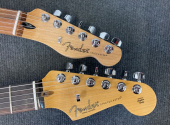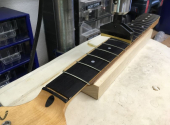Under the Hood #34: A Timeline History of Fender (Part 2)
In the second part of a more detailed history of Fender, let's take a look at the end of the 60s, the course of the 70s and the very beginning of the 80s. By that time, the Fender brand had been fully established, with a lot of changes in guitar design and many innovations. At the same time, some models had been discontinued. So let's recall some of the milestones, personalities and significant changes that took place at Fender, which shaped the development of not only the company but also the entire world of music.
Late 60s
1969: End of production of Esquire and Duo Sonic
At the end of the 1960s, two models were discontinued. In 1969, the production of the first the Esquire model made by Fender ended because Telecaster and other models were much more popular then. After all, the Esquire offered musicians a slightly narrow range of use. However, the end of production of this model did not mean its demise – in the 1980s the company began producing Fender Japan.
In the same year, 1969, production of the Duo Sonic ended. It was a popular student model, but more preferred at the time was the Mustang – more or less the same instrument, but with minor improvements. The discontinuation of the Duo Sonic was, therefore, an understandable choice.
1969: Maple fretboards made again
In 1969, Fender began using all maple necks again, as in the 1950s. The back of the neck again features a skunk stripe, or wood inlay, which mends the channel for the truss rod.
1970: Eric Clapton creates the legendary Stratocaster Blackie
In 1970, Eric Clapton buys several older Stratocaster models and assembles them into one model that would become iconic. Because of its black colour, it gets the name Blackie, and for the next 15 years, it becomes Clapton's main guitar.
1971: Change of neck attachment design
The year 1971 is full of changes in guitar design. The most important one is the change of the neck attachment to the body of the guitar. This had previously been done with four screws to make the joint reliable. Now the fit is changed to three screws only. The neck plate has, therefore, also a different shape and is now oval.
However, not all instruments would be affected by this change. Classic models, the Telecaster and Precision bass, still have a four-bolt joint. Other Telecaster models, i.e. Thinline, Custom or Telecaster bass, have the neck attached to the body with three screws.
1971: Bullet truss rod
Another design change is the placement of the adjustable end of the neck truss rod. Previously, the end of the truss rod had been at the heel or at the neck’s end adjoining the body of the guitar. Now it has been placed at the beginning of the neck near the headstock, and its end is bullet-shaped, hence the name Bullet.
Again, this change does not affect all models – the Precision bass and classic Telecaster are spared.
1971: A second string tree appears on the guitar headstock
Since 1971, a slight modification to the headstock design has been made, with a second string tree gradually being added to some models. Now the string trees are therefore placed on four strings. This change is of particular benefit to the G string, which gains more pressure at the zero fret.
1971: New humbuckers on the Thinline Telecaster
The Telecaster Thinline received new pickups in 1971. Two humbuckers gave it a specifically predatory look and a great sound.
1972/73: Design change on Jazz Bass
Another important model that switched to a three-bolt neck/body joint construction was the Jazz Bass.
1975: The end of Jaguar production
In 1975, the production of the Jaguar model ends. It was a popular and sophisticated model, and, paradoxically, it only became popular thanks to the emerging wave of punk in the years to come. Later in the 1990s, thanks to Kurt Cobain, Jaguar became more famous than during its prime production era in the 1960s and 1970s.
1976: Serial number on the headstock of guitars
By 1976, guitars were dated in several ways. However, the principle was that the neck was dated only on the heel. Now there is a change and the serial number appears on the headstock under the Fender logo.
1977: Breakthrough in Stratocaster electronics
From the start of production, the Stratocaster provided a very wide range of sound, thanks to its three pickups. However, until 1977, the switching between pickups had been done by a three-position switch. This meant that only one pickup was activated in each switch position. Over the years, guitarists have noticed that if they set the switch lever to an intermediate position, they activated two pickups simultaneously. However, this has only been a temporary solution then.
With a full five-position pickup switch, where two pickups were activated together in the intermediate positions, Stratocaster players gained two entirely new and unique sounds. This gave the Stratocaster a more subtle character to its sound. At the same time, the hum of the single coils was cancelled out thanks to the winding of the pickup coils in the interposition, which was another undeniable advantage.
This small, but actually big upgrade has taken the Stratocaster to the next level.
1979: First Stratocaster anniversary model
In 1979, Fender launched the Stratocaster anniversary model. This move was made with the idea of paying homage to this iconic model, which celebrated twenty-five years since its introduction that year.
Basically, it was a regular Stratocaster that was mass marketed in 1979, but with minor and limited modifications. The biggest difference was the paint colour, which was silver after the initial rigmarole. The tuning mechanics were also atypical. The body was inscribed "Anniversary" and the neck-body joint again had four screws. This foreshadowed the coming change in the design of this joint back to the tried and tested four-screw variant.
The 80s
1980: Return of the four-bolt neck/body joint in series production
While a year earlier, the Stratocaster anniversary model again featured the tried and trusted four-bolt neck/body joint, the regular 1979 Stratocaster still has a three-bolt joint.
By 1980, all Stratocasters were being built with a four-bolt neck/body construction. Fender was beginning to react to a significant decline in the quality of its guitars.
1980: Fender using both versions of the adjustable truss rod
With the change in the neck/body joint comes a change in the design of the truss rod. Now the solution differs on various models and the customer can buy a model with an adjustable truss rod end typically at the heel or with the so-called Bullet truss rod.
1981: Dan Smith and the beginning of the Fender revival
In 1981, several experienced personnel joined Fender from Yamaha, among them Dan Smith, a man who would hold a significant place in Fender's history for his approach to the quality of the instruments and thanks to all his and his staff's achievements with the entire brand.
He focused on production processes, analysed procedures, checked product quality and employee motivation in order to turn things around... All this will be recapped in the next part of our series.
If you have found an error or typo in the article, please let us know by e-mail info@insounder.org.



